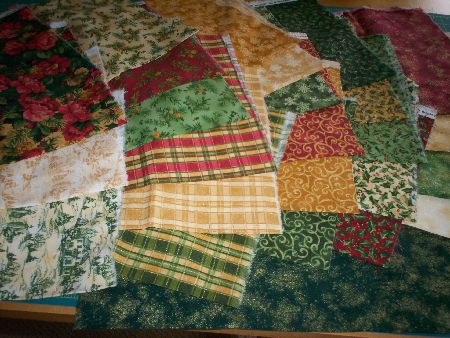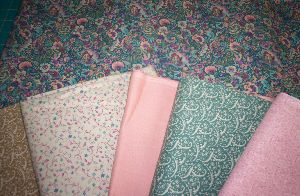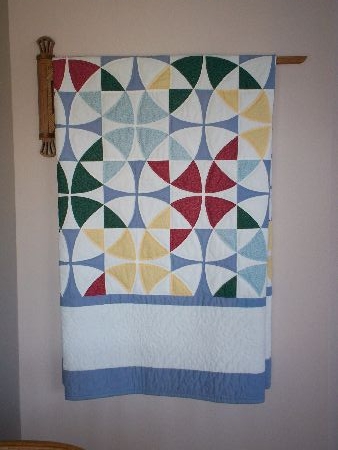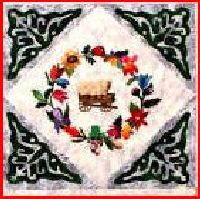Sometimes we quilters and ME's want to do what we want to do. We buy books with patterns made by somebody whose tastes are similar to ours, but we want to do it our way. How can I arrange my favorite quilt blocks in a new and different way without taking hours with graph paper, a ruler and colored pencils? If you are new to quilting, you may not have a complete understanding of how to put different fabrics, colors and blocks together in a way that will make you stand back and say "WOW!"
I've been quilting for a long time, but I still don't have a "designer's brain." I just don't have the imagination that a real quilt designer has. Color can be a real bugaboo for quilters, new and old. It takes a whole lot of confidence to put colors together that won't fight each other. You can make a few test blocks to see if colors work. But then you put 30 or 40 blocks together in a quilt, your imagination explodes in a disastrous pile of scraps. Shucks, what do I do now?

Enter Quilt Design Wizard, by Electric Quilt. It's a very easy quilt design program. I'll keep you posted on what I'm learning with this neat program that is available at our very own AnnTheGran store. Click the link to view it in a new window.
Now I'll give you a "scrap" of my knowledge about fabrics. Hmmm, what do I say on the subject, because the selection of fabrics is such an individual subject. I'll try to give you a few tips I've learned along the way. My main thing to tell you is . . . buy the best quality fabrics you can afford. I know, I know, I've said that before. But it's important for you to remember that the quality of your finished product (quilt) depends most on the quality of the fabrics that go into it. The quality of the finished product (quilt) may/will become an heirloom. (That is if your son-in-law, brother, son, whatever) doesn't think it will make a great throw/blanket to work on his car or use as a saddle blanket. That makes me cringe, but I've heard of it happening.
Second, it's also important not to mix 100% cotton fabric with cotton/poly blends. Cotton fabrics just perform differently than blends. There is a small amount of horizontal (selvage to selvage) stretch to cotton fabrics. There is practically no stretch to blends. It's OK to use either one together, just don't mix them. I have seen the result of a beginning quilter who tried to mix the two, just because she found fabric she liked, but didn't realize that it would give her a big problem, trying to sew them together. She never completed the project, and became so frustrated that as far as I know she never tried to piece a quilt again.
Avoid fabric that is stiff. That's a common sign that there is a lot of sizing (similar to spray starch) in the fabric to make it look good. (Kinda like they wax apples to make them look pretty in the produce department) Fabrics should feel comfortable enough to wear. I make a lot of shirts for myself. My favorite kind of fabric for a shirt is a fabric from a quality quilt shop. They feel wonderful when they are finished and they come out of the wash like permanent press, even though they are all cotton.
You’ll find a list of fabric terms at the end of this post.
How much do I buy? If you think you will be a fabric collector, keep two things in mind: your budget and your storage space. When I moved out of my old house, I had about sixteen rubbermaid bins, of various sizes, loaded with fabric. That's the reason my husband built those FINE shelves that are pictured in my first post in this blog.
The amount of fabric depends on several things. Do I like this fabric so much that it calls, "Take me home with you?!" That kind of fabric . . . you buy at least three yards, no matter whether you know what to do with it or not.  Really, if you like a fabric well enough to use it as the focal point of a quilt, buy plenty, at least three yards or what a pattern calls for. Then use it as the main fabric and find other fabrics that coordinate for the other pieces of your quilt. Also, buy three yards if you think you want it for sashing or a border. If you want it for the backing of a quilt, buy six yards or more, depending on the size of the quilt. I have often bought only one yard and later wish I had a lot more of it. When you have a pattern in mind, carefully choose fabrics by the yardage chart on the pattern. THEN, buy 1/4 yard more at least, just in case you need more, or make a mistake/miscut. Fabrics come and go. It seems to be a law of the universe that if you run out of a fabric, and try to buy more, it HAS been discontinued. I speak from experience. My advice is, be safe and buy ½ yard more. In the picture below, you'll see a group of fabrics that would go well together in a quilt.
Really, if you like a fabric well enough to use it as the focal point of a quilt, buy plenty, at least three yards or what a pattern calls for. Then use it as the main fabric and find other fabrics that coordinate for the other pieces of your quilt. Also, buy three yards if you think you want it for sashing or a border. If you want it for the backing of a quilt, buy six yards or more, depending on the size of the quilt. I have often bought only one yard and later wish I had a lot more of it. When you have a pattern in mind, carefully choose fabrics by the yardage chart on the pattern. THEN, buy 1/4 yard more at least, just in case you need more, or make a mistake/miscut. Fabrics come and go. It seems to be a law of the universe that if you run out of a fabric, and try to buy more, it HAS been discontinued. I speak from experience. My advice is, be safe and buy ½ yard more. In the picture below, you'll see a group of fabrics that would go well together in a quilt.

Also, here is a group of fabrics by the same designer. There are twenty-two fabrics that are designed to go together in any way. It’s nice to choose a whole line of fabric from one designer, because you don’t have to worry so much about matching.

Fabric preparation: There are varying opinions of whether to prewash or not to prewash. I personally, don't prewash unless the fabrics are dark of vivid colors that I really expect to run or bleed. (purples, reds, blues and blacks) If you do prewash, use a good gentle detergent, like Orvus paste soap. This is a soap that was originally made as soap for washing livestock. It is gentle and quilters discovered it and began using it for quilts. It rinses out well and is gentle on any fine washables. It is available in bulk at livestock supply stores and quilt shops in smaller containers. I once bought a gallon of Orvus at a livestock supply and divided it among quilting friends. It is very reasonably priced that way. I use it for any hand washables.
One little hint about fat quarters, they are half-yard cuts of fabric that are cut down the center, making a fabric rectangle. It is about 22" x 18", approximately the same size of a regular quarter yard of fabric, but in a much more usable piece, since it is longer in length. (18 inches long as opposed to 9 inches long.)
Question, questions, anyone? Feel free to ask anything. If I don't know the answer, I'll find the answer for you. I promise not to ask my husband. He'd give me an answer, whether it's right or not, and say it's the truth. Actually, he's been around my sewing so long, he offered to describe how I straighten fabrics for making clothes. He could do it, but for quilting the fabrics are cut up into small pieces and it doesn't make a difference. 

Someone always comments about my quilts, so here is a fix for this time. This quilt hangs on a wall hanger that my husband made for it.

By the way, I have taken the plunge and decided to begin another really big applique quilt. This one may take a thousand years, too, but I just gotta do SOMETHING with my hands. As a matter of fact, I think I'll sign off for this time and go watch some TV while I start that new thousand year quilt.
Stitches to you, - - - - - - - - - - - - - - - - - - - - - - - - - - - - - - - - - - - - - - - - -(very even hand quilted stitches)
LaRue
Quilter's Jargon:
Bias: The diagonal of woven fabrics. The true bias is the 45-degree angle of a piece of fabric. When cut on the bias, fabric has more stretch than a piece cut on the straight grain. Bias strips are good to use for curves in applique designs, and for a scalloped binding.
Grain: A woven fabric is composed of threads woven horizontally and vertically. The grain refers to the way the straight threads are woven together. On a sewing pattern, the grain is often shown with a long arrow printed on the fabric. That arrow shows the direction that a pattern should be lying on the fabric.
Right and wrong side: Printed fabrics have a right and wrong side. The shinier, more defined print is the right side of the fabric. The dull side is the wrong side. Pay close attention when laying pattern pieces so as not to waste fabric by cutting is out wrong.
Selvage: The cross grain of the fabric goes back and forth across the lengthwise threads, and wraps over the edge. That edge is the selvage. The selvage is nearly always cut off the fabric before cutting patterns or strips.
Orvus paste soap: A gentle soap that was originally made as soap for washing livestock. Quilters discovered it and began using it for quilts.